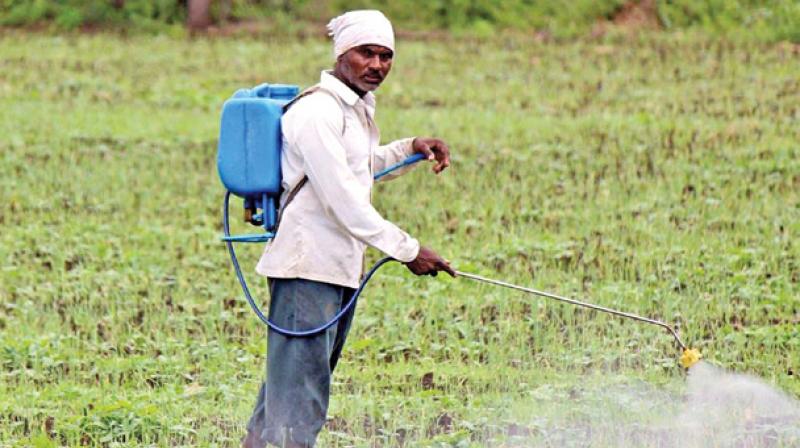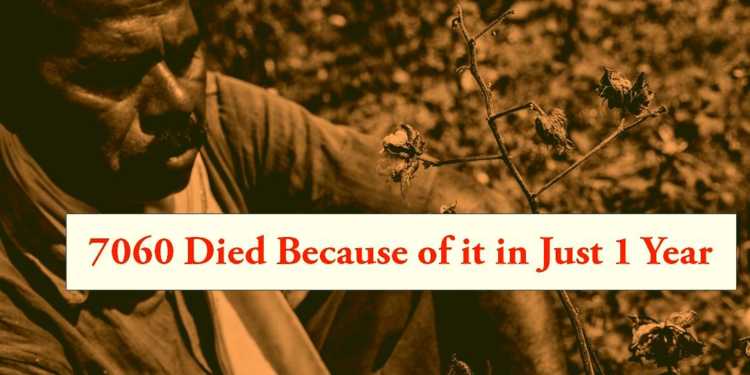Recent unfortunate events in Yavatmal, Maharashtra where pesticides seemed to have claimed the life of at least 20 farmers and poisoned hundreds of others have brought the glare back on the dangers of pesticides and insecticides. These chemicals, which have seemingly become a necessity of modern day agriculture, have been spelling trouble for a large number of farmers since several years now. In fact, National Crime Records Bureau (NCRB) Report on Accidental Deaths and Suicides in India shows that there were 7, 672 cases and 7, 060 deaths in India due to accidental exposure to pesticides or insecticides in 2015 alone, which translates to almost 11% of total number of such accidental deaths. The corresponding figures for suicides by consumption of insecticides is much higher- 23, 930 or 17.9% of all suicides in 2015. These figures though staggering are just the tip of the iceberg, as WHO estimates peg the number of exposures and fatalities due to pesticides at 6,00,000 and 60,000 respectively per year, which means that such cases are grossly underreported.
What is thus clear from the above data is that accidental or intentional exposure to pesticides is indeed a significant problem. India is the second largest consumer of pesticides in Asia after China and the 12th largest in the world, no wonder for a nation where half of the workforce and a sixth of the GDP depends on agriculture.

Moreover, with our erratic monsoons and poor spread of canals and other alternative means of irrigation, farmers are forced to rely on extensive use of pesticides to maximise their yield from the land.
What makes Pesticides deadly?
What is deadly for an insect, can be so for humans too as at the molecular level, the machinery running life is pretty much the same. In the Yavatmal incident, the pesticide behind the tragedy is suspected to be Profex Super, a combination of Propenofos and Cypermethrin. Now, Propenofos belongs to the family of Organophosphorus compounds, so renowned for their lethal potential, that some members of the family are used as agents of chemical warfare. These compounds bind to Acetylcholine-estrase (AChE), an enzyme which metabolises Acetylcholine (ACh-a major neurotransmitter or signal molecule in the nervous and neuromuscular system) and render AChE ineffective. This leads to increased concentrations of ACh in the body, which pushes the nervous and neuromuscular system into a state of overdrive. Moreover, the attachment of the pesticide to the enzyme becomes irreversible after 24-48 hours. This results in symptoms like excessive salivation, lacrimation, urination, defecation, vomiting and in a matter of few hours, if the exposure of the person to the agent is strong enough, leads to fatiguing of the respiratory muscles and respiratory failure, which is the most common cause of death. Cypermethrin and most other pesticides also have effects on the brain and nerves and can be lethal themselves or in combination with other compounds present in pesticides. And this was acute poisoning, repetitive exposure to even small doses over many years can cause chronic poisoning which affects behaviour, judgement, movement and other aspects of the central and peripheral nervous system.
Exposure can occur via inhalation of fumes, ingestion (usually in suicides) or even across the skin. Other factors like duration and frequency of exposure also matter when it comes to toxicity. It is advised that farmers rest for a day or two after applying the pesticide once, but in most cases farmers expose themselves on a repeated basis in the race to get the entire crop covered in time. In the Yavatmal tragedy, it is suspected that the humid weather, increased height of the cotton crop (which makes the farmer spray the pesticide higher up above his head, increasing risk of inhalation), use of new Chinese spray pumps (which spray larger concentrations of the pesticides into the air at faster speeds, thereby increasing exposure) and use of certain compounds called ‘stickers’ in combination with the pesticide cocktail to make it stick effectively to the crop (while increasing the amount of pesticide getting stuck to the skin of the person applying it as well) are being examined as possible factors which led to the unfortunate deaths.
Other factors suspected to have played a role in the tragedy are inadequate education of farmers about the hazards that these compounds pose, sellers tempting farmers into buying the most toxic compounds and drug cocktails by advertising maximum effect at minimal dose and safety instructions being written in small English letterings, rendering it illegible for most of the cultivators. Also, India still uses outdated Bt Cotton seeds of the second generation. They have been in use for more than a decade now, rendering them vulnerable to attacks from new varieties of pests which are resistant to the intrinsic toxin introduced via genetic modification in the cotton plant and increasing dependence on insecticides.
PREVENTING SUCH TRAGEDIES FROM RECURRING:
Such tragedies are easily preventable, and steps need to be taken both on an immediate basis and on a long term policy basis to ensure the safety and well being of our farmers. The former include better farmer education so as to impart adequate knowledge about the hazards of pesticides and the correct dose and technique of applying them to the crop safely. Also, the warnings need to be printed prominently on the pesticide can in a language that the farmer can understand. Additionally, farmers need to be trained to identify signs of pesticide poisoning in fellow farmers and to rush them to the nearest medical facility without delay in case of suspected poisoning.
On a policy basis, we need to gradually encourage farmers to shift from the resource and chemical intensive current practices to more sustainable and safe practices like Integrated Pest Management (IPM). IPM is a holistic approach, which seeks to minimise synthetic interventions in the farmlands, and instead focuses on using nature synergistic practices to keep adequate control on pests and ensure good crop yield at reasonable costs. Use of natural predators of the pests to keep them in check is one example of an IPM practice.
Also, we need to rethink our blanket opposition towards the bio-technologically modified crops and consider if introducing these varieties into India would result in better yields and lesser use of these toxic pesticides. Of course, before allowing their introduction, every aspect of their safety should be tested and concerns of some parties about allowing some MNCs to monopolise the seed market need to be addressed. If we could develop indigenous pest resistant varieties by promoting research in this arena, it could perhaps be a wonderful boost to the Make In India initiative. Striking a balance between modern techniques like drip irrigation and traditional practices like use of cow dung manure could indeed be the way forward towards ensuring ‘Jay Kisaan’ and doubling of farm incomes as promised by Hon. PM Shri Narendra Modi.


































